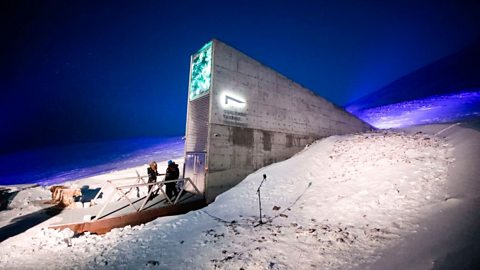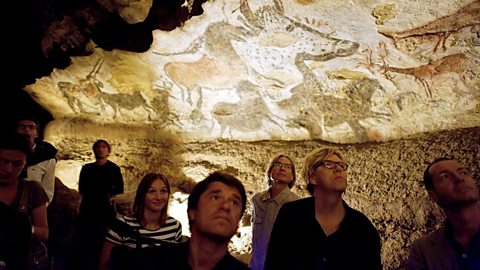In today’s world, there can’t be many places which haven’t been snapped, shared and hashtagged by tourists.
But there are some. While the majority of places on the planet welcome visitors, there are others which must remain closed off to the general public. It could be for safety, legal or scientific reasons, but one thing they share is being strictly off limits. В鶹№ЩНшКЧТіИлїЪ Bitesize takes a look at some of them, while making sure not to step in any restricted areas.
Norway’s seed vault that could save us from catastrophe
In the event of a global catastrophe, humans and animals run the risk of vital crops being wiped out for good.
Luckily, there is an insurance policy in place - in the shape of a seed vault which opened in Norway in 2008. If the world ever needed to begin its harvests from scratch, the seeds stored here could be used. They are kept in special packets, sealed in such a way to protect them from moisture. That’s one level of protection - the other comes from the location itself.

The vault is on a remote island called Spitsbergen in the Arctic Svalbard A cluster or collection of islands.. It is set 120 metres (393ft) inside a sandstone mountain, which stands around 1,300km (807 miles) from the North Pole. At 130m (426ft) above sea level, the site can stay dry and the thick Permanently frozen soil. surrounding the vault helps preserve the hundreds of thousands of seed samples stored within.
Another reason Spitsbergen was selected was its lack of earthquake activity, but while the seeds are as safely stored as good planning makes possible, the one thing you can’t do is check out the facility for yourself. The vault is heavily secured and guarded, ensuring the seeds within can survive for thousands of years if necessary.
Ilha da Queimada - the island that’s potentially venomous for visitors
This 43-hectare island off the Brazilian coast is not an advisable destination for a day trip. It is home to a species of venomous snake called the golden lancehead, one so deadly that one bite is enough to stop the birds they prey on before they can fly away. There are estimates of between one to five snakes for every square metre of the island, so the Brazilian government has banned anyone from setting foot on Ilha de Queimada, known as Snake Island, as a precaution.
The only exception to this are scientific researchers, who must be accompanied by a doctor during their trip. For anyone else fascinated by the golden lancehead snake, they can be viewed in captivity in other parts of Brazil.
Lascaux - the French cave covered in precious art
Four teenagers searching for a dog which had disappeared down a hole discovered this cave in southern France in 1940. In the happiest of accidents, their dog had led them to a cave covered in wall paintings of animals such as horse and deer. Dating back around 17,000 years, it was one of the most well-preserved examples of prehistoric art ever discovered, with around 600 paintings and 1,000 engravings in total.
When the discovery was made, the Second World War was in its infancy. Eight years later, the cave in Lascaux was opened to curious members of the public who wanted to see their ancestors’ handiwork up close.

In 1963, public visits were stopped, due to a mould sprouting on the walls. It threatened the artwork which had existed in airtight conditions before their discovery. Fungus outbreaks have continued to happen there since, even with strict restrictions on the number of people allowed inside.
Almost 60 years later, the cave is still largely off-limits to the public, although a replica site has been built next door for tourists.
Uluru - the sacred site in the Australian outback
A recent addition to the list of places the public is not allowed to visit, Uluru - once known as Ayers Rock - was a tourist attraction for many years. Visitors could previously attempt the 348m (1,142ft) ascent to the summit, although it did mean facing extreme heat - with summer temperatures around 47C (116F) - and the steep climb could also cause difficulties.
Uluru is sacred to the The original people of a region existing with their own culture, society and political structures before the arrival of foreign colonisers. Anangu Aboriginal people who are the custodians of the rock and long wanted visitors to stop climbing it out of respect for their traditions. This wish was backed unanimously by a petition from the board of the Uluru-Kata Tjuta National Park and the decision to stop people setting foot on Uluru was made in 2017. On 25 October 2019, the last day people were allowed to climb the rock before the ban came into operation, long queues of last-minute tourists formed.
In Anangu culture, Uluru is evidence that celestial beings came to Earth when it was still unformed and without life. They travelled across it, creating living species and forms, such as Uluru, along the way. Visitors can still come to Uluru-Kata Tjuta National Park but the sacred rock may only be observed these days, and never tread upon.
This article was published in February 2022.
Five of history's most surprising bans
No popcorn in cinemas? Or football in England and Scotland?

The Regenerators
Learn about sustainability in school and at home.

The Bitesize art movements quiz
Who was that Pop Art hero? And which famous name helped create Cubism?
